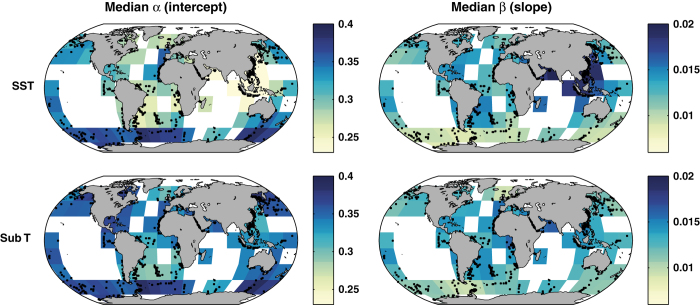Abstract
Quantitative estimates of past temperature changes are a cornerstone of paleoclimatology. For a number of marine sediment-based proxies, the accuracy and precision of past temperature reconstructions depends on a spatial calibration of modern surface sediment measurements to overlying water temperatures. Here, we present a database of 1095 surface sediment measurements of TEX86, a temperature proxy based on the relative cyclization of marine archaeal glycerol dialkyl glycerol tetraether (GDGT) lipids. The dataset is archived in a machine-readable format with geospatial information, fractional abundances of lipids (if available), and metadata. We use this new database to update surface and subsurface temperature calibration models for TEX86 and demonstrate the applicability of the TEX86 proxy to past temperature prediction. The TEX86 database confirms that surface sediment GDGT distribution has a strong relationship to temperature, which accounts for over 70% of the variance in the data. Future efforts, made possible by the data presented here, will seek to identify variables with secondary relationships to GDGT distributions, such as archaeal community composition.
Subject terms: Palaeoceanography, Biogeochemistry, Climate change, Palaeoclimate
Background & Summary
The reconstruction of past changes in ocean temperatures allows us to understand the behavior of the Earth’s climate system, including internal and external drivers of oceanic variability, climate sensitivity, and ocean-atmosphere interactions. A number of techniques are available to infer past temperatures from ocean sediment archives, some employing the inorganic chemical composition of calcified fossils1,2, and others the distribution of fossil lipids, or ‘biomarkers’, produced by specific organisms3,4. The latter category includes the TEX86 (TetraEther indeX of 86 carbons) proxy, based on the relative cyclization of isoprenoidal glycerol dialkyl glycerol tetraethers (GDGTs) produced by marine archaea. GDGTs are cell membrane lipids, and archaea alter the composition of these lipids in response to environmental temperature in order to optimize membrane packing and fluidity5–7. Mesocosm experiments demonstrate that marine archaea produce relatively more lipids with a greater number of rings at higher temperatures8,9.
TEX86 is an index designed to quantify the relative degree of cyclization4. It is defined as:
where GDGTs 1–3 are compounds containing 1–3 cyclopentyl moieties, respectively, and cren' denotes the regioisomer of crenarchaeol, a characteristic lipid for Thaumarchaeota10. By definition, values of the TEX86 index span 0–1. Fig. 1a shows the structures of these compounds. GDGTs are analyzed via High-Performance Liquid Chromatography-Mass Spectrometry (HPLC-MS); Fig. 1b shows their typical appearance in a HPLC-MS chromatogram.
Figure 1. Molecular structures and HPLC detection of GDGTs.
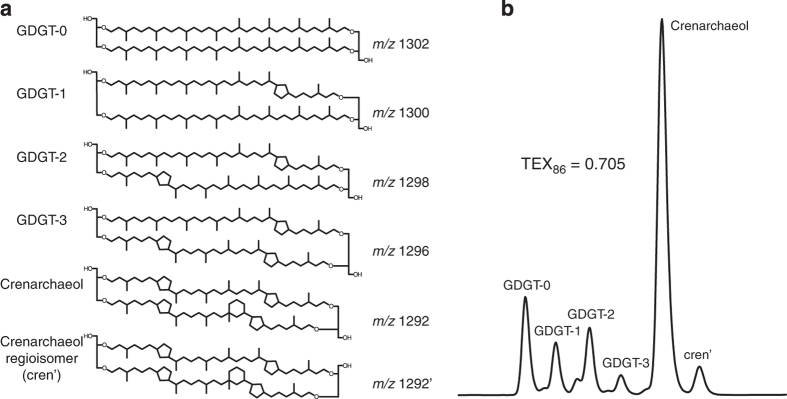
(a) Structures of the isoprenoidal GDGTs that comprise the TEX86 proxy, along with Crenarchaeol, a diagnostic lipid for Thaumarchaeota10. (b) A typical HPLC-MS trace of the isoprenoidal GDGTs and corresponding TEX86 value.
Pelagic, nitrifying Thaumarchaeota are believed to be the primary10,11, but likely not exclusive12 producers of GDGTs in the marine environment. These organisms typically inhabit the upper water column, but may reside anywhere in the epi- or meso-pelagic zone13–15. The strong empirical relationship between TEX86 and sea-surface temperatures (SSTs)4,16–19 has led to the widespread use of TEX86 to reconstruct past SSTs on both recent20 and ancient timescales21. However, in environments with steep thermoclines and nutriclines, Thaumarchaeota may reside deeper in the water column (e.g., 50–200 meters depth) and record subsurface temperature variability11,19,22–25. Therefore, TEX86 may be used to reconstruct either SST or subsurface temperatures, depending on the oceanographic conditions.
Calibration of the TEX86 index to temperatures relies on a collection of modern surface sediments, for which overlying water temperatures are known from historical observations4,16–18. Modern surface data are continuously published in disparate journals, making aggregation of the data for calibration purposes difficult. Here, we present a database of 1095 surface sediment TEX86 measurements, which may be used to calibrate the TEX86 proxy and investigate relationships between TEX86 and other environmental variables. We also present updated versions of the BAYSPAR (Bayesian, Spatially-Varying Regression)18 calibration for TEX86 based on this new data collection, including both surface temperature (SST) and subsurface temperature (Sub-T) models.
Methods
Data aggregation
TEX86 data (n=1095) were collated from the literature and from direct contact with individual researchers (Fig. 2). Our collection includes data represented in previous global calibration efforts16–18, data published as part of regional surface sediment studies24,26–42, surface sediment data produced as part of a sedimentary TEX86 timeseries43–48, and previously unpublished data. The TEX86 measurements in this database were reported by the original authors and contributors to be modern or at the least, late Holocene in age, and therefore generally representative of present-day temperatures. All TEX86 data entries are accompanied by geospatial information. In some cases, authors archived the relative abundances of individual compounds. We compiled this information when available (see Data Records below).
Figure 2. The distribution of sedimentary core top data in the global TEX86 database.
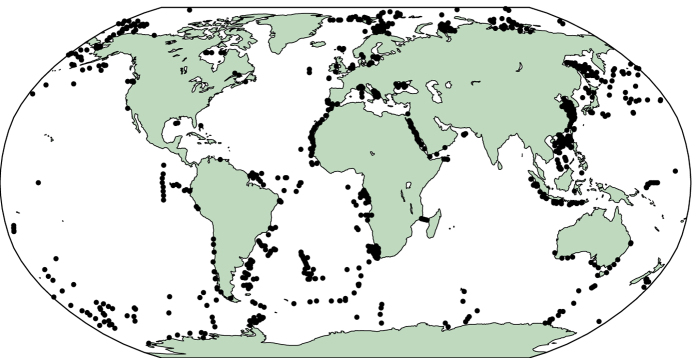
Analytical determination of TEX86
Although the data in this collection derive from multiple publications and laboratories, TEX86 values were determined using the same HPLC-MS analysis method49. Briefly, extracts of sediment material containing GDGTs were dissolved in a mixture of hexane and isopropanol, injected into a HPLC, then separated on a Prevail Cyano column using a gradient spanning hexane:isopropanol (99:1) to hexane:isopropanol (98.2:1.8). The solvent stream is then sent to a mass spectrometer operated in single-ion monitoring (SIM) mode, scanning only target compound mass-to-charge ratios. The type of mass spectrometer (e.g., single quadrupole, ion trap) may be different between laboratories, but previous research has shown that there is no bias in TEX86 associated with different types of mass spectrometers50. TEX86 is calculated from integrating peak areas of the target compounds. Within a single laboratory, analytical error is typically 0.004 TEX86 units or better50,51, or about 0.3 °C when calibrated. Interlaboratory uncertainties are nearly an order-of-magnitude larger (0.03 TEX86 units50,51), equivalent to about 2–3 °C.
BAYSPAR calibration model
We have previously developed a Bayesian, spatially-varying regression (BAYSPAR) model18 for the calibration of TEX86. The adoption of this model was motivated by observations that the TEX86 response to temperature varies across different oceanic basins and environments26,35, the existence of strong spatial trends in the residuals of previous calibration models18,19, and the need to fully propagate uncertainties into resulting temperature predictions.
BAYSPAR assumes the regression parameters are constant within 20° by 20° latitude-longitude grid boxes, but imposes a spatial model on the intercepts (the vector α) and slopes (β) that forces nearby grid boxes to feature similar parameter values, with the degree of similarity controlled by a data-informed spatial decorrelation length scale. This hierarchical approach produces a calibration that is a data-determined compromise between a globally constant calibration and a set of independent local calibrations52,53. The calibration model is specified via the following set of equations:
The vector P consists of all core-top TEX86 observations; C is a diagonal matrix containing all temperature observations; and M is a selection matrix of zeros and ones, with each row containing a single one, such that corresponding entries of the vectors MCβ and P are at the same location in space. α and β are, respectively, vectors of spatially varying intercept and slope terms; along with the error variance, τ 2 (I denotes the identity matrix), they are the parameters of primary interest in calibrating the TEX86–temperature relationship. Spatial dependence arises from the specification of both α and β as stationary and isotropic Gaussian processes in space, defined on the centroids of 20° by 20° grid boxes, and with constant means given by μ α and μ β , respectively. indicates a truncated normal, defined on the positive half of the real line, reflecting the a priori assumption of a positive relationship between TEX86 and temperatures. Finally, R denotes the Matérn correlation function53, defined by a smoothness parameter ν, which we set to 3/2, and an inverse spatial range parameter, ϕ, that measures the strength of the spatial dependence. To provide mathematical closure, priors are required for all scalar parameters of the calibration model. With the exception of ϕ, which can be challenging to estimate54–56, we use proper but weakly informative priors.
Prediction of temperature conditional on an observed TEX86 value proceeds by a second application of Bayes rule to invert Equation 2 for temperature in terms of TEX86. A prior distribution on the temperature is also required, and, to propagate uncertainty, we integrate over the posterior distributions of the calibration parameters. In practice, this is achieved by repeatedly sampling from the posterior distributions of the calibration parameters, and then drawing from the posterior predictive distribution of temperatures conditional on the TEX86 observation, the current draw of the calibration parameters, and the prior on past temperature.
Under certain oceanographic conditions, TEX86 may be recording subsurface, rather than surface, temperature variability11,19,22–24. Several subsurface calibrations have been proposed in the past16,23,25. We therefore present separate calibrations of the BAYSPAR model using both modern SST climatologies, and a modern climatology of sub-surface temperatures (Sub-T). The formalism is the same in each case, except that, for the Sub-T calibration, the target temperatures are set as weighted averages of the 0–200 meters water depth, with weights given by the gamma probability density function (Fig. 3). We chose this weighting function to approximate evidence from water column studies that GDGT production occurs predominantly between 0–200 meters but likely reaches peak abundance in the shallow subsurface24,57,58. Initial experiments using a simple average between 0–200 meters resulted in poor fit, especially in shallow regions of the global ocean (not shown). In keeping with previous findings that TEX86 has a weak relationship to temperatures in the high latitudes of the Arctic ocean18,35 we exclude data north of 70° N in both calibration models.
Figure 3. Gamma function probability distribution that represents the averaging scheme for the subsurface temperature calibration.
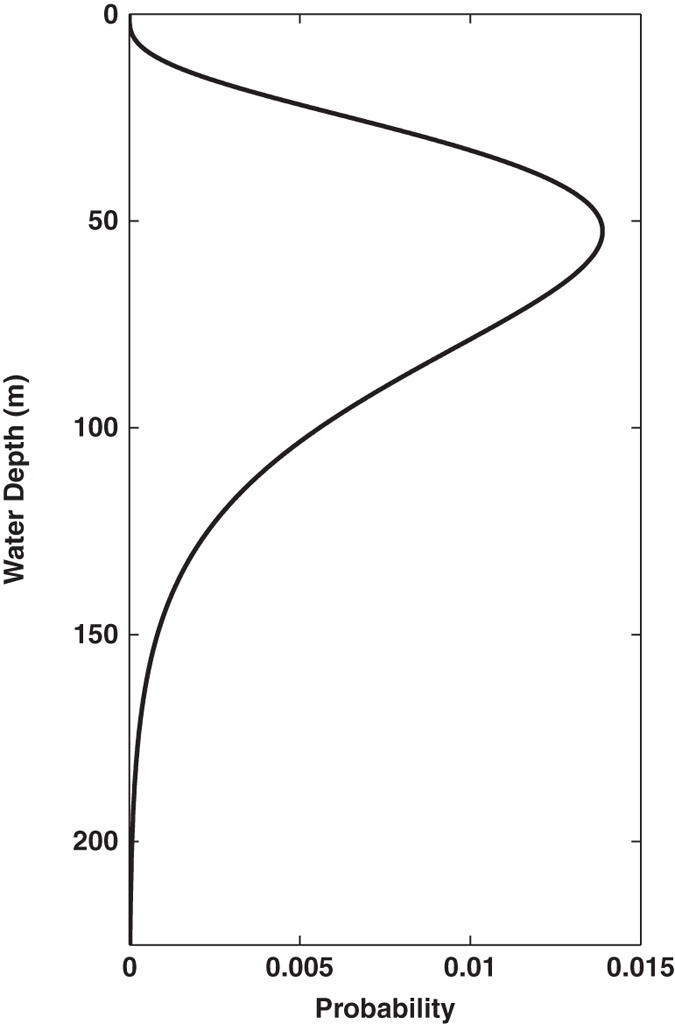
The gamma distribution parameters are a=4.5 and b=15.
Data Records
The TEX86 surface sediment database is archived at the National Oceanic and Atmospheric Administration's National Climatic Data Center for Paleoclimatology: http://www.ncdc.noaa.gov/paleo/study/18615 in machine-readable ASCII format (http://www.ncdc.noaa.gov/data-access/paleoclimatology-data/contributing). The database is also archived on Figshare (Data Citation 1). Each data entry includes the following information:
Geospatial information, including latitude, longitude and (if available) recorded water depth at the collection site.
Sediment core information, including the name of the core, type of core (e.g., gravity, piston), and depth at which the TEX86 sample was taken.
TEX86 value and (if available) fractional abundances of the six main isoprenoidal GDGTs.
Overlying sea-surface temperatures and gamma-averaged (Fig. 3) subsurface temperatures derived from the 1°×1° World Ocean Atlas 2009 product59 (https://www.nodc.noaa.gov/OC5/WOA09/pr_woa09.html) and sea-surface temperatures from the 0.25°×0.25° NOAA daily Optimum Interpolation Sea Surface Temperature (OISST) 1981–present climatology based on Advanced Very-High Resolution Radiometer (AVHRR) measurements60 (http://www.ncdc.noaa.gov/oisst).
Name and DOI of the associated reference, if available.
The database includes all available sedimentary TEX86 data as of January 2015. This version of the database and the accompanying calibrations is designed as version 1.0. The authors will update the database, and the BAYSPAR calibrations, yearly with newly published sediment core top data; previous versions of the database and calibrations will be archived at the NCDC for posterity.
Technical Validation
The new TEX86 data compilation shows a clear relationship with both SST and Sub-T (subsurface temperatures), which respectively account for 72 and 73% of the variance in the TEX86 data (Fig. 4). The relationship is not straightforwardly linear due to regional differences in the TEX86-temperature slope. In particular, and in agreement with previous findings18,35, the TEX86-temperature relationship features a lower slope at higher latitudes, and there is more scatter about the regression relationship in the Arctic region (Fig. 4). The reasons for the poor relationship between TEX86 and temperatures in the Arctic remain unclear. In some locations it may reflect interference from terrestrial or sedimentary methanogenic/methanotrophic sources of GDGTs35 but could also plausibly indicate the presence of different pelagic archaeal producers. Whatever the case, the scatter in the data and the subsequent collapse in predictability18 justify their current exclusion from global calibration models.
Figure 4. Scatterplots of the TEX86 database versus a. sea-surface temperature (SST), and b. subsurface (Sub-T; 0–200 meters, gamma averaged) temperature.
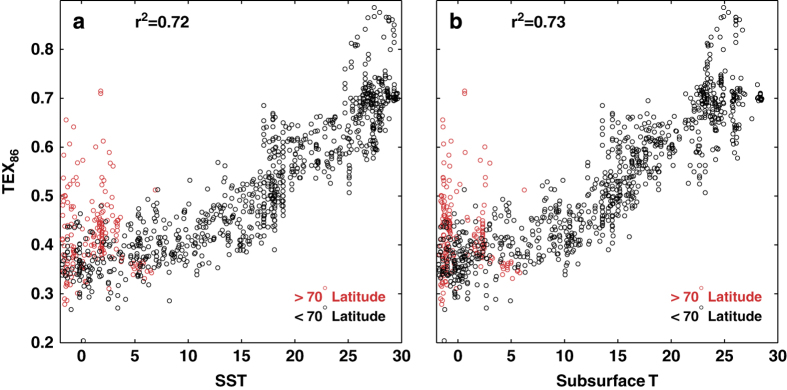
Red dots denote data located above 70°N latitude; black dots denote all other data.
In agreement with our previous work18, both the SST and Sub-T (subsurface temperature) BAYSPAR calibrations show spatial variation in the α (intercept) and β (slope) parameters that reflect the regional differences in the TEX86 response to temperature variations (Fig. 5). Globally, for the SST (Sub-T) model, β varies by 30% (22%) and α varies by 22% (10%). The relatively smaller variance of the parameters in the Sub-T model, particularly in the case of α, may indicate a slightly less globally-variable TEX86 response when calibrating to a deeper water temperature.
Figure 5. Spatially-varying median α (intercept) and β (slope) values calculated by BAYSPAR, for the SST model (top) and subsurface temperature (Sub-T) model (bottom).
Small black dots denote the locations of the surface sediment TEX86 data.
Calibration uncertainties vary spatially as a function of data availability, and as a function of β, with lower β values associated with higher uncertainties (Fig. 6). For the SST model, calibration uncertainties vary between 1.2–10 °C with a median of 5 °C; for the Sub-T model, they vary between 1.4–9 °C with a median of 5 °C. Unlike the existing least squares calibrations16,17,61, and in agreement with our previous calibrations18, we do not detect any significant trends in the residuals as a function of latitude (for the SST model, ρ=−0.07, P=0.11, while for the sub T model, ρ=−0.05, P=0.27, where ρ is the Spearman correlation).
Figure 6. Spatially-varying 1σ uncertainties (a) and residuals (b) for the SST and Sub-T BAYSPAR models.
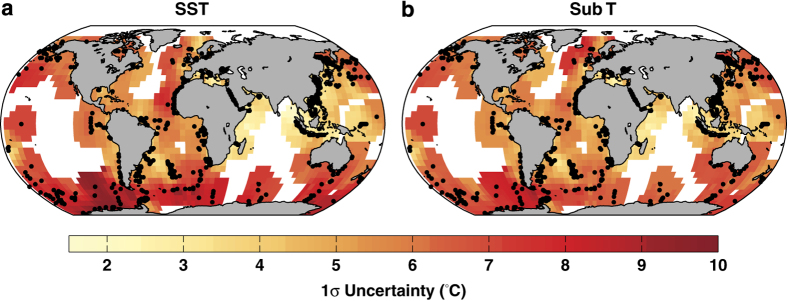
Black dots denote the locations of the surface sediment TEX86 data.
We provide an example application of the new BAYSPAR calibration, based on the updated TEX86 core top dataset, to demonstrate applicability and usage (Fig. 7). In this case, we apply the SST calibration to predict SSTs for the past 25,000 years at a site in the eastern Mediterranean44. We find that the predicted temperatures are in reasonable agreement with independent alkenone-based SST estimates down core (Fig. 7a), indicating that the use of an SST model at this site is appropriate. One advantage of our Bayesian approach is that predictions take the form of posterior probability distributions as opposed to single time series with error bars (Fig. 7a). Probabilistic reconstructions of this form permit for a statistically rigorous assessment of a much broader array of scientific issues62–65. For example, we can estimate the probability that the late Holocene time period (0–4 ka) was the warmest period of the past 25,000 years by identifying the warmest time point in each ensemble member. We find that intervals throughout the Holocene feature non-negligible probabilities of experiencing the warmest conditions, such that we cannot conclude at any reasonable level of significance that the late Holocene was the warmest period (Fig. 7b). In addition, we can estimate the magnitude of the LGM-Holocene temperature difference at this location that fully accounts for the uncertainties in the proxy estimates (Fig. 7c). The posterior median for LGM cooling is −9.5 °C, with a 90% uncertainty interval of (−11.6, −7.9) °C.
Figure 7. An example application of the TEX86 BAYSPAR model.
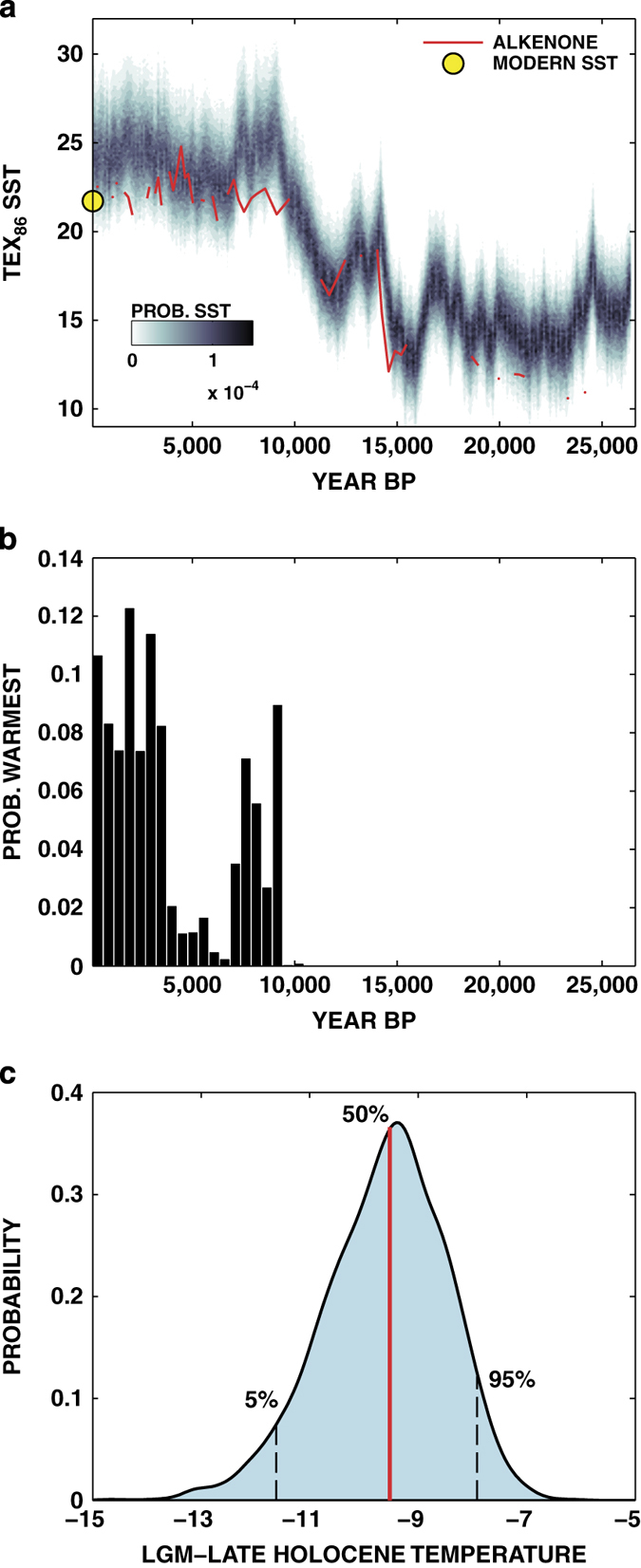
(a) Posterior SST probability densities, derived from the application of the SST calibration to TEX86 data from the eastern Mediterranean44. Alkenone-based SST estimates (in red) are shown for comparison, and the yellow dot denotes WOA09 modern mean annual SST59. (b) Probability that each time point featured the warmest conditions over the time span of data, binned by 500 year intervals. (c) Probability density of LGM-Late Holocene temperatures, showing 5th, 50th, and 95th percentiles.
The performance of our new BAYSPAR calibrations and their application demonstrate the general ability of the new TEX86 database to provide predictions of past changes in both surface and subsurface temperatures. The choice of whether to calibrate to surface or sub-surface temperatures is ultimately up to the user, although we recommend that it be informed not only by the target variable that the user seeks to predict but also an understanding of the oceanography of the location from which the data derive. As previous investigations have shown22,28, a Sub-T calibration is likely the most suitable choice for regions with steep thermoclines and nutriclines, such as upwelling zones. The database may also foster future investigations into secondary influences on the distribution of isoprenoidal GDGTs in marine sediments, such as lipid contributions from different archaeal communities12,66,67.
Usage Notes
Updated Matlab code that enables users to apply the latest BAYSPAR calibrations is available for download at Figshare: http://dx.doi.org/10.6084/m9.figshare.1348830. The BAYSPAR calibration may also be used online at http://www.whoi.edu/bayspar.
Additional Information
How to cite this article: Tierney, J. E. & Tingley, M. P. A TEX86 surface sediment database and extended Bayesian calibration. Sci. Data 2:150029 doi: 10.1038/sdata.2015.29 (2015).
Supplementary Material
Acknowledgments
The authors would like to thank Laura Fleming for assistance with the development of the BAYSPAR website.
Footnotes
The authors declare no competing financial interests.
Data Citations
- Tierney J. E., Tingley M. P. 2015. Figshare . [DOI]
References
- Emiliani C. Pleistocene temperatures. The Journal of Geology 63, 538–578 (1955). [Google Scholar]
- Erez J. & Luz B. Experimental paleotemperature equation for planktonic foraminifera. Geochim. Cosmochim. Acta 47, 1025–1031 (1983). [Google Scholar]
- Brassell S. C., Eglinton G., Marlowe I. T., Pflaumann U. & Sarnthein M. Molecular stratigraphy—a new tool for climatic assessment. Nature 320, 129–133 (1986). [Google Scholar]
- Schouten S., Hopmans E. C., Schefuß E. & Sinninghe Damsté J. S. Distributional variations in marine crenarchaeotal membrane lipids: a new tool for reconstructing ancient sea water temperatures? Earth Planet. Sci. Lett. 204, 265–274 (2002). [Google Scholar]
- deRosa M., Esposito E., Gambacorta A., Nicolaus B. & Bu'Lock J. Effects of temperature on ether lipid composition of Caldariella acidophila. Phytochemistry 19, 827–831 (1980). [Google Scholar]
- Gliozzi A., Paoli G., De Rosa M. & Gambacorta A. Effect of isoprenoid cyclization on the transition temperature of lipids in thermophilic archaebacteria. Biochimica et Biophysica Acta (BBA)-Biomembranes 735, 234–242 (1983). [Google Scholar]
- Uda I., Sugai A., Itoh Y. & Itoh T. Variation in molecular species of polar lipids from Thermoplasma acidophilum depends on growth temperature. Lipids 36, 103–105 (2001). [DOI] [PubMed] [Google Scholar]
- Wuchter C., Schouten S., Coolen M. J. L. & Sinninghe Damsté J. S. Temperature-dependent variation in the distribution of tetraether membrane lipids of marine Crenarchaeota: Implications for TEX86 paleothermometry. Paleoceanography 19, PA4028 (2004). [Google Scholar]
- Schouten S., Forster A., Panoto E. & Sinninghe Damsté J. S. Towards calibration of the TEX86 palaeothermometer for tropical sea surface temperatures in ancient greenhouse worlds. Org. Geochem. 38, 1537–1546 (2007). [Google Scholar]
- Sinninghe Damsté J. S., Hopmans E. C., Schouten S., van Duin A. C. T. & Geenevasen J. A. J. Crenarchaeol: the characteristic core glycerol dibiphytanyl glycerol tetraether membrane lipid of cosmopolitan pelagic crenarchaeota. J. Lipid Res. 43, 1641–1651 (2002). [DOI] [PubMed] [Google Scholar]
- Schouten S., Hopmans E. C. & Sinninghe Damsté J. S. The organic geochemistry of glycerol dialkyl glycerol tetraether lipids: A review. Organic Geochemistry 54, 19–61 (2013). [Google Scholar]
- Lincoln S. A. et al. Planktonic Euryarchaeota are a significant source of archaeal tetraether lipids in the ocean. Proceedings of the National Academy of Sciences 111, 9858–9863 (2014). [DOI] [PMC free article] [PubMed] [Google Scholar]
- Massana R., Murray A., Preston C. & DeLong E. Vertical distribution and phylogenetic characterization of marine planktonic Archaea in the Santa Barbara Channel. Appl. Environ. Microbiol. 63, 50–56 (1997). [DOI] [PMC free article] [PubMed] [Google Scholar]
- Wuchter C., Schouten S., Wakeham S. G. & Sinninghe Damsté J. S. Temporal and spatial variation in tetraether membrane lipids of marine crenarchaeota in particulate organic matter: Implications for tex86 paleothermometry. Paleoceanography 20, PA3013 (2005). [Google Scholar]
- Ingalls A. E. et al. Quantifying archaeal community autotrophy in the mesopelagic ocean using natural radiocarbon. Proc. Nat. Acad. Sci. U.S.A 103, 6442–6447 (2006). [DOI] [PMC free article] [PubMed] [Google Scholar]
- Kim J.-H., Schouten S., Hopmans E. C., Donner B. & Sinninghe Damsté J. S. Global sediment core-top calibration of the TEX86 paleothermometer in the ocean. Geochim. Cosmochim. Acta 72, 1154–1173 (2008). [Google Scholar]
- Kim J. et al. New indices and calibrations derived from the distribution of crenarchaeal isoprenoid tetraether lipids: Implications for past sea surface temperature reconstructions. Geochim. Cosmochim. Acta 74, 4639–4654 (2010). [Google Scholar]
- Tierney J. E. & Tingley M. P. A Bayesian, spatially-varying calibration model for the TEX86 proxy. Geochimica et Cosmochimica Acta 127, 83–106 (2014). [Google Scholar]
- Tierney J. E. Biomarker-based inferences of past climate: The TEX86 paleotemperature proxyInTurekian K. K. & Holland H. D.(eds.) Treatise on Geochemistry vol. 12, chap. 12.14 379–393 (Elsevier, 2014)2 edn. [Google Scholar]
- Tierney J. et al. Late-twentieth-century warming in Lake Tanganyika unprecedented since AD 500. Nature Geoscience 3, 422–425 (2010). [Google Scholar]
- Jenkyns H. C., Forster A., Schouten S. & Sinninghe Damsté J. S. High temperatures in the late cretaceous arctic ocean. Nature 432, 888–892 (2004). [DOI] [PubMed] [Google Scholar]
- Lopes Dos Santos R. et al. Glacial-interglacial variability in Atlantic meridional overturning circulation and thermocline adjustments in the tropical North Atlantic. Earth Planet. Sci. Lett. 300, 407–414 (2010). [Google Scholar]
- Kim J. et al. Holocene subsurface temperature variability in the eastern Antarctic continental margin. Geophysical Research Letters 39, L06705 (2012). [Google Scholar]
- Chen W., Mohtadi M., Schefuß E. & Mollenhauer G. Organic-geochemical proxies of sea surface temperature in surface sediments of the tropical eastern Indian Ocean. Deep Sea Research Part I: Oceanographic Research Papers 88, 17–29 (2014). [Google Scholar]
- Kim J.-H. et al. Influence of deep-water derived isoprenoid tetraether lipids on the paleothermometer in the Mediterranean Sea. Geochimica et Cosmochimica Acta 150, 125–141 (2015). [Google Scholar]
- Trommer G. et al. Distribution of Crenarchaeota tetraether membrane lipids in surface sediments from the Red Sea. Org. Geochem. 40, 724–731 (2009). [Google Scholar]
- Leider A., Hinrichs K., Mollenhauer G. & Versteegh G. Core-top calibration of the lipid-based and TEX86 temperature proxies on the southern Italian shelf (SW Adriatic Sea, Gulf of Taranto). Earth Planet. Sci. Lett. 300, 112–124 (2010). [Google Scholar]
- Chazen C. Holocene climate evolution of the eastern tropical Pacific told from high resolution climate records from the Peru margin and equatorial upwelling regions. Ph.D. thesis, 252 pp (Brown University, 2011).
- Ho S., Yamamoto M., Mollenhauer G. & Minagawa M. Core top TEX86 values in the south and equatorial Pacific. Organic Geochemistry 42, 94–99 (2011). [Google Scholar]
- Shevenell A., Ingalls A., Domack E. & Kelly C. Holocene Southern Ocean surface temperature variability west of the Antarctic Peninsula. Nature 470, 250–254 (2011). [DOI] [PubMed] [Google Scholar]
- Wei Y. et al. Spatial variations in archaeal lipids of surface water and core-top sediments in the South China Sea and their implications for paleoclimate studies. Applied and environmental microbiology 77, 7479–7489 (2011). [DOI] [PMC free article] [PubMed] [Google Scholar]
- Fallet U. et al. Sedimentation and burial of organic and inorganic temperature proxies in the Mozambique Channel, SW Indian Ocean. Deep Sea Research Part I: Oceanographic Research 59, 37–53 (2012). [Google Scholar]
- Jia G., Zhang J., Chen J., Peng P. & Zhang C. L. Archaeal tetraether lipids record subsurface water temperature in the South China Sea. Organic Geochemistry 50, 68–77 (2012). [Google Scholar]
- Smith M. et al. Comparison of , TEX86, and LDI temperature proxies for reconstruction of south-east Australian ocean temperatures. Organic Geochemistry 64, 94–104 (2013). [Google Scholar]
- Ho S. L. et al. Appraisal of TEX86 and thermometries in subpolar and polar regions. Geochimica et Cosmochimica Acta 131, 213–226 (2014). [Google Scholar]
- Seki O. et al. Assessment and calibration of TEX86 paleothermometry in the Sea of Okhotsk and sub-polar North Pacific region: Implications for paleoceanography. Progress in Oceanography 126, 254–266 (2014). [Google Scholar]
- Kaiser J. et al. Lipid biomarkers in surface sediments from the Gulf of Genoa, Ligurian sea (NW Mediterranean sea) and their potential for the reconstruction of palaeo-environments. Deep Sea Research Part I: Oceanographic Research Papers 89, 68–83 (2014). [Google Scholar]
- Lü X. et al. Sources and distribution of isoprenoid glycerol dialkyl glycerol tetraethers (GDGTs) in sediments from the east coastal sea of China: Application of GDGT-based paleothermometry to a shallow marginal sea. Organic Geochemistry 75, 24–35 (2014). [Google Scholar]
- Zhou H., Hu J., Spiro B., Peng P. & Tang J. Glycerol dialkyl glycerol tetraethers in surficial coastal and open marine sediments around China: Indicators of sea surface temperature and effects of their sources. Palaeogeography, Palaeoclimatology, Palaeoecology 395, 114–121 (2014). [Google Scholar]
- Zell C. et al. Sources and distributions of branched and isoprenoid tetraether lipids on the Amazon shelf and fan: Implications for the use of GDGT-based proxies in marine sediments. Geochimica et Cosmochimica Acta 139, 293–312 (2014). [Google Scholar]
- Park Y.-H. et al. Distribution, source and transportation of glycerol dialkyl glycerol tetraethers in surface sediments from the western Arctic Ocean and the northern Bering Sea. Marine Chemistry 165, 10–24 (2014). [Google Scholar]
- Lengger S. K., Hopmans E. C., Damsté J. S. S. & Schouten S. Impact of sedimentary degradation and deep water column production on GDGT abundance and distribution in surface sediments in the Arabian Sea: Implications for the TEX86 paleothermometer. Geochimica et Cosmochimica Acta 142, 386–399 (2014). [Google Scholar]
- Seki O. et al. Large changes in seasonal sea ice distribution and productivity in the Sea of Okhotsk during the deglaciations. Geochem. Geophys. Geosys 10, Q10007 (2009). [Google Scholar]
- Castañeda I. et al. Millennial-scale sea surface temperature changes in the eastern Mediterranean (Nile River Delta region) over the last 27,000 years. Paleoceanography 25, PA1208 (2010). [Google Scholar]
- Richey J., Hollander D., Flower B. & Eglinton T. Merging late Holocene molecular organic and foraminiferal-based geochemical records of sea surface temperature in the Gulf of Mexico. Paleoceanography 26, PA1209 (2011). [Google Scholar]
- Verleye T. The late Quaternary palaeoenvironmental changes along the western South-American continental slope: A reconstruction based on dinoflagellate cysts and TEX86. Ph.D. thesis, 243 pp (Ghent University, 2011).
- Wu W., Tan W., Zhou L., Yang H. & Xu Y. Sea surface temperature variability in southern Okinawa Trough during last 2700 years. Geophysical Research Letters 39, L14705 (2012). [Google Scholar]
- Nieto-Moreno V. et al. Climate conditions in the westernmost Mediterranean over the last two millennia: an integrated biomarker approach. Organic Geochemistry 55, 1–10 (2013). [Google Scholar]
- Schouten S., Huguet C., Hopmans E. C., Kienhuis M. V. M. & Sinninghe Damsté J. S. Analytical methodology for TEX86 paleothermometry by high-performance liquid chromatography/atmospheric pressure chemical ionization-mass spectrometry. Anal. Chem. 79, 2940–2944 (2007). [DOI] [PubMed] [Google Scholar]
- Schouten S. et al. An interlaboratory study of TEX86 and BIT analysis using high-performance liquid chromatography–mass spectrometry. Geochemistry, Geophysics, Geosystems 10, Q03012 (2009). [Google Scholar]
- Schouten S. et al. An interlaboratory study of TEX86 and BIT analysis of sediments, extracts, and standard mixtures. Geochemistry, Geophysics, Geosystems 14, 5263–5285 (2013). [Google Scholar]
- Gelman A., Carlin J., Stern H. & Rubin D. Bayesian Data Analysis, 2 edn. (Chapman & Hall/CRC, Boca Raton, 2003). [Google Scholar]
- Banerjee S., Carlin B. P. & Gelfand A. E. Hierarchical Modeling and Analysis for Spatial Data. (Chapman & Hall/CRC, New York, 2004). [Google Scholar]
- Zhang H. Inconsistent estimation and asymptotically equal interpolations in model-based geostatistics. Journal of the American Statistical Association 99, 250–261 (2004). [Google Scholar]
- Tingley M. P. & Huybers P. A Bayesian Algorithm for Reconstructing Climate Anomalies in Space and Time. Part 1: Development and applications to paleoclimate reconstruction problems. Journal of Climate 23, 2759–2781 (2010). [Google Scholar]
- Mannshardt E., Craigmile P. & Tingley M. P. Statistical modeling of extreme value behavior in North American tree-ring density series. Climatic Change 117, 843858 (2013). [Google Scholar]
- Schouten S. et al. Intact polar and core glycerol dibiphytanyl glycerol tetraether lipids in the Arabian Sea oxygen minimum zone: I. Selective preservation and degradation in the water column and consequences for the TEX86. Geochimica et Cosmochimica Acta 98, 228–243 (2012). [Google Scholar]
- Basse A. et al. Distribution of intact and core tetraether lipids in water column profiles of suspended particulate matter off Cape Blanc, NW Africa. Organic Geochemistry 72, 1–13 (2014). [Google Scholar]
- Locarnini R. A. et al. in NOAA Atlas NESDIS (ed. Levitus S.), vol. 68, 1–184 (U.S. Government Printing Office, Washington, DC, 2010). [Google Scholar]
- Reynolds R. W. et al. Daily high-resolution-blended analyses for sea surface temperature. Journal of Climate 20, 5473–5496 (2007). [Google Scholar]
- Liu Z. et al. Global cooling during the Eocene-Oligocene climate transition. Science 323, 1187–1190 (2009). [DOI] [PubMed] [Google Scholar]
- NRC. Surface Temperature Reconstructions for the Last 2000 Years. (The National Academies Press: Washington, D.C., 2006). [Google Scholar]
- Kopp R., Simons F., Mitrovica J., Maloof A. & Oppenheimer M. Probabilistic assessment of sea level during the last interglacial stage. Nature 462, 863–867 (2009). [DOI] [PubMed] [Google Scholar]
- Tingley M. et al. Piecing together the past: Statistical insights into paleoclimatic reconstructions. Quaternary Science Reviews 35, 1–22 (2012). [Google Scholar]
- Tingley M. P. & Huybers P. Recent temperature extremes at high northern latitudes unprecedented in the past 600 years. Nature 496, 201–205 (2013). [DOI] [PubMed] [Google Scholar]
- Turich C. et al. Lipids of marine Archaea: Patterns and provenance in the water-column and sediments. Geochim. Cosmochim. Acta 71, 3272–3291 (2007). [Google Scholar]
- Taylor K. W., Huber M., Hollis C. J., Hernandez-Sanchez M. T. & Pancost R. D. Re-evaluating modern and Palaeogene GDGT distributions: Implications for SST reconstructions. Global and Planetary Change 108, 158–174 (2013). [Google Scholar]
Associated Data
This section collects any data citations, data availability statements, or supplementary materials included in this article.
Data Citations
- Tierney J. E., Tingley M. P. 2015. Figshare . [DOI]



